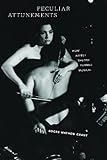Peculiar Attunements : How Affect Theory Turned Musical / Roger Mathew Grant.
Material type: TextPublisher: New York, NY : Fordham University Press, [2020]Copyright date: ©2020Description: 1 online resource (192 p.) : 1Content type:
TextPublisher: New York, NY : Fordham University Press, [2020]Copyright date: ©2020Description: 1 online resource (192 p.) : 1Content type: - 9780823288083
- Doctrine of the affections
- Emotions in music
- Mimesis in music
- Music -- Physiological effect
- Music -- Europe -- 18th century -- Philosophy and aesthetics
- Literary Studies
- Music
- Philosophy & Theory
- MUSIC / Philosophy & Social Aspects
- Aesthetics
- Affect
- Attunement
- Emotions
- Hegel
- Music Theory
- Opera
- Rameau
- Rousseau
- Sound
- online - DeGruyter
| Item type | Current library | Call number | URL | Status | Notes | Barcode | |
|---|---|---|---|---|---|---|---|
 eBook
eBook
|
Biblioteca "Angelicum" Pont. Univ. S.Tommaso d'Aquino Nuvola online | online - DeGruyter (Browse shelf(Opens below)) | Online access | Not for loan (Accesso limitato) | Accesso per gli utenti autorizzati / Access for authorized users | (dgr)9780823288083 |
Browsing Biblioteca "Angelicum" Pont. Univ. S.Tommaso d'Aquino shelves, Shelving location: Nuvola online Close shelf browser (Hides shelf browser)

|

|

|

|

|

|

|
||
| online - DeGruyter Dictionary Poetics : Toward a Radical Lexicography / | online - DeGruyter Send Lazarus : Catholicism and the Crises of Neoliberalism / | online - DeGruyter Urban Formalism : The Work of City Reading / | online - DeGruyter Peculiar Attunements : How Affect Theory Turned Musical / | online - DeGruyter The Geological Unconscious : German Literature and the Mineral Imaginary / | online - DeGruyter Merleau-Ponty's Poetic of the World : Philosophy and Literature / | online - DeGruyter The Fact of Resonance : Modernist Acoustics and Narrative Form / |
Frontmatter -- Contents -- Notes on orthography and translation -- Introduction -- 1. Eighteenth-century opera and the mimetic affektenlehre -- 2. Comic opera: Mimesis exploded -- 3. “Sonate, que me veux-tu?” and other dilemmas of instrumental music -- 4. The attunement affektenlehre -- Coda: affect after the affektenlehre -- Acknowledgments -- Bibliography -- Index
restricted access online access with authorization star
http://purl.org/coar/access_right/c_16ec
Peculiar Attunements places the recent turn to affect into conversation with a parallel movement in European music theory of the eighteenth century. During that time the affects—or passions, as they were also called—formed a vital component of a mimetic model of the arts. Eighteenth-century critics held that artworks imitated or copied the natural world in order to produce copies of the affects in their beholders. But music caused a problem for such theories, since it wasn’t apparent that musical tones could imitate anything with any dependability, beyond the rare thunderclap or birdcall.Struggling to articulate how it was that music managed to move its auditors without imitation, certain theorists developed a new affect theory crafted especially for music, postulating that music’s physical materiality as sound vibrated the nerves of listeners and attuned them to the affects through sympathetic resonance. This was a theory of affective attunement that bypassed the entire structure of representation, offering a non-discursive, corporeal alternative. It is a pendant to contemporary theories of affect, and one from which they have much to learn. Inflecting our current intellectual moment through eighteenth-century music theory and aesthetics, this book offers a reassessment of affect theory’s common systems and processes. It offers a new way of thinking through affect dialectically, drawing attention to patterns and problems in affect theory that we have been given to repeating. Finally, taking a cue from eighteenth-century theory, it gives renewed attention to the objects that generate affects in subjects.
Mode of access: Internet via World Wide Web.
In English.
Description based on online resource; title from PDF title page (publisher's Web site, viewed 25. Jun 2024)


